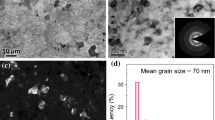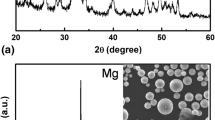Abstract
This paper reports the corrosion resistant and cytocompatible properties of the hyaluronic acid-silane coating on AZ31 Mg alloy. In this study, the osteoinductive properties of high molecular weight hyaluronic acid (HA, 1–4 MDa) and the corrosion protection of silane coatings were incorporated as a composite coating on biodegradable AZ31 Mg alloy for orthopaedic applications. The multi-step fabrication of coatings first involved dip coating of a passivated AZ31 Mg alloy with a methyltriethoxysilane-tetraethoxysilane sol-gel to deposit a dense, cross-linked and corrosion resistant silane coating (AZ31-MT). The second step was to create an amine-functionalised surface by treating coated alloy with 3-aminopropyl-triethoxy silane (AZ31-MT-A) which facilitated the immobilisation of HA via EDC-NHS coupling reactions at two different concentrations i.e 1 mg.ml−1 (AZ31-MT-A-HA1) and 2 mg.ml−1 (AZ31-MT-A-HA2). These coatings were characterised by Fourier transform infrared spectroscopy, atomic force microscopy and static contact angle measurements which confirmed the successful assembly of the full coatings onto AZ31 Mg alloy. The influence of HA-silane coating on the corrosion of Mg alloy was investigated by electrical impedance spectroscopy and long-term immersion studies measurements in HEPES buffered DMEM. The results showed an enhanced corrosion resistance of HA functionalised silane coated AZ31 substrate over the uncoated equivalent alloy. Furthermore, the cytocompatibility of MC3T3-E1 osteoblasts was evaluated on HA-coated AZ31-MT-A substrates by live-dead staining, quantification of total cellular DNA content, scanning electron microscope and alkaline phosphatase activity. The results showed HA concentration-dependent improvement of osteoblast cellular response in terms of enhanced cell adhesion, proliferation and differentiation. These findings hold great promise in employing such biomimetic multifunctional coatings to improve the corrosion resistance and cytocompatibility of biodegradable Mg-based alloy for orthopaedic applications.







Similar content being viewed by others
References
Witte F, Fischer J, Nellesen J, Crostack HA, Kaese V, Pisch A et al. In vitro and in vivo corrosion measurements of magnesium alloys. Biomaterials. 2006;27:1013–8. https://doi.org/10.1016/j.biomaterials.2005.07.037.
Walker J, Shadanbaz S, Woodfield TBF, Staiger MP, Dias GJ. Magnesium biomaterials for orthopedic application: a review from a biological perspective. J Biomed Mater Res - Part B Appl Biomater. 2014;102:1316–31. https://doi.org/10.1002/jbm.b.33113.
Sanchez AHM, Luthringer BJC, Feyerabend F, Willumeit R. Mg and Mg alloys: How comparable are in vitro and in vivo corrosion rates? A review. Acta Biomater. 2015;13:16–31. https://doi.org/10.1016/j.actbio.2014.11.048.
Xin Y, Hu T, Chu PK. In vitro studies of biomedical magnesium alloys in a simulated physiological environment: a review. Acta Biomater. 2011;7:1452–9. https://doi.org/10.1016/j.actbio.2010.12.004.
Agarwal S, Curtin J, Duffy B, Jaiswal S. Biodegradable magnesium alloys for orthopaedic applications: a review on corrosion, biocompatibility and surface modifications. Mater Sci Eng C. 2016;68:948–63. https://doi.org/10.1016/j.msec.2016.06.020.
Whelan M, Cassidy J, Duffy B. Sol-gel sealing characteristics for corrosion resistance of anodised aluminium. Surf Coat Technol. 2013;235:86–96. https://doi.org/10.1016/j.surfcoat.2013.07.018.
Song J, Ooij WJVan. Bonding and corrosion protection mechanisms of γ-APS and BTSE silane films on aluminum substrates. J Adhes Sci Technol. 2003;17:2191–21. https://doi.org/10.1163/156856103772150788.
Shalabi MM, Wolke JGC, Cuijpers VMJI, Jansen Ja. Evaluation of bone response to titanium-coated polymethyl methacrylate resin (PMMA) implants by X-ray tomography. J Mater Sci Mater Med. 2007;18:2033–9. https://doi.org/10.1007/s10856-007-3160-0.
Agarwal S, Morshed M, Labour MN, Hoey D, Duffy B, Curtin J et al. Enhanced corrosion protection and biocompatibility of a PLGA–silane coating on AZ31 Mg alloy for orthopaedic applications. RSC Adv. 2016;6:113871–83. https://doi.org/10.1039/C6RA24382G.
Gu XN, Li N, Zheng YF, Ruan L. In vitro degradation performance and biological response of a Mg-Zn-Zr alloy. Mater Sci Eng B Solid-State Mater Adv Technol. 2011;176:1778–84. https://doi.org/10.1016/j.mseb.2011.05.032.
Zhao N, Wang X, Qin L, Guo Z, Li D. Effect of molecular weight and concentration of hyaluronan on cell proliferation and osteogenic differentiation in vitro. Biochem Biophys Res Commun. 2015;465:569–74. https://doi.org/10.1016/j.bbrc.2015.08.061.
Kunjukunju S, Roy A, Ramanathan M, Lee B, Candiello JE, Kumta PN. A layer-by-layer approach to natural polymer-derived bioactive coatings on magnesium alloys. Acta Biomater. 2013;9:8690–703. https://doi.org/10.1016/j.actbio.2013.05.013.
D’Sa RA, Dickinson PJ, Raj J, Pierscionek BK, Meenan BJ. Inhibition of lens epithelial cell growth via immobilisation of hyaluronic acid on atmospheric pressure plasma modified polystyrene. Soft Matter. 2011;7:608–17. https://doi.org/10.1039/C0SM00936A.
Takahashi T, Ikegami-Kawai M, Okuda R, Suzuki K. A fluorimetric Morgan-Elson assay method for hyaluronidase activity. Anal Biochem. 2003;322:257–63. https://doi.org/10.1016/j.ab.2003.08.005.
Homayun B, Afshar A. Microstructure, mechanical properties, corrosion behavior and cytotoxicity of Mg-Zn-Al-Ca alloys as biodegradable materials. J Alloy Compd. 2014;607:1–10. https://doi.org/10.1016/j.jallcom.2014.04.059.
Bobe K, Willbold E, Morgenthal I, Andersen O, Studnitzky T, Nellesen J et al. In vitro and in vivo evaluation of biodegradable, open-porous scaffolds made of sintered magnesium W4 short fibres. Acta Biomater. 2013;9:8611–23. https://doi.org/10.1016/j.actbio.2013.03.035.
Chou DT, Hong D, Saha P, Ferrero J, Lee B, Tan Z et al. In vitro and in vivo corrosion, cytocompatibility and mechanical properties of biodegradable Mg-Y-Ca-Zr alloys as implant materials. Acta Biomater. 2013;9:8518–33. https://doi.org/10.1016/j.actbio.2013.06.025.
Pandey M, Kapila R, Kapila S. Osteoanabolic activity of whey-derived anti-oxidative (MHIRL and YVEEL) and angiotensin-converting enzyme inhibitory (YLLF, ALPMHIR, IPA and WLAHK) bioactive peptides. Peptides. 2018;99:1–7. https://doi.org/10.1016/j.peptides.2017.11.004.
Majoul N, Aouida S, Bessaïs B. Progress of porous silicon APTES-functionalization by FTIR investigations. Appl Surf Sci. 2015;331:388–91. https://doi.org/10.1016/j.apsusc.2015.01.107.
Almeida PV, Shahbazi M-A, Mäkilä E, Kaasalainen M, Salonen J, Hirvonen J et al.Amine-modified hyaluronic acid-functionalized porous silicon nanoparticles for targeting breast cancer tumors. Nanoscale. 2014;6:10377–87.https://doi.org/10.1039/c4nr02187h.
Liu X, Huang R, Su R, Qi W, Wang L, He Z. Grafting hyaluronic acid onto gold surface to achieve low protein fouling in surface plasmon resonance biosensors. ACS Appl Mater Interfaces. 2014;6:13034–42. https://doi.org/10.1021/am502921z.
King AD, Birbilis N, Scully JR. Accurate electrochemical measurement of magnesium corrosion rates; a combined impedance, mass-loss and hydrogen collection study. Electrochim Acta. 2014;121:394–406. https://doi.org/10.1016/j.electacta.2013.12.124.
Srinivasan A, Shin KS, Rajendran N. Influence of bicarbonate concentration on the conversion layer formation onto AZ31 magnesium alloy and its electrochemical corrosion behaviour in simulated body fluid. RSC Adv. 2016;6:49910–22. https://doi.org/10.1039/C6RA08478H.
Weeks A, Boone A, Luensmann D, Jones L, Sheardown H. The effects of hyaluronic acid incorporated as a wetting agent on lysozyme denaturation in model contact lens materials. J Biomater Appl. 2012;28:323–33. https://doi.org/10.1177/0885328212446936.
Liu X, Yue Z, Romeo T, Weber J, Scheuermann T, Moulton S. et al. Biofunctionalized anti-corrosive silane coatings for magnesium alloys. Acta Biomater. 2013;9:8671–7. https://doi.org/10.1016/j.actbio.2012.12.025.
Jamesh M, Kumar S, Narayanan TSNS. Electrodeposition of hydroxyapatite coating on magnesium for biomedical applications. J Coat Technol Res. 2012;9:495–502. https://doi.org/10.1007/s11998-011-9382-6.
Dezfuli SN, Huan Z, Mol JMC, Leeflang MA, Chang J, Zhou J. Influence of HEPES buffer on the local pH and formation of surface layer during in vitro degradation tests of magnesium in DMEM. Prog Nat Sci Mater Int. 2014;24:531–8. https://doi.org/10.1016/j.pnsc.2014.08.009.
Kawano M, Ariyoshi W, Iwanaga K, Okinaga T, Habu M, Yoshioka I et al. Mechanism involved in enhancement of osteoblast differentiation by hyaluronic acid. Biochem Biophys Res Commun. 2011;405:575–80. https://doi.org/10.1016/j.bbrc.2011.01.071.
Chua PH, Neoh KG, Kang ET, Wang W. Surface functionalization of titanium with hyaluronic acid/chitosan polyelectrolyte multilayers and RGD for promoting osteoblast functions and inhibiting bacterial adhesion. Biomaterials. 2008;29:1412–21. https://doi.org/10.1016/j.biomaterials.2007.12.019.
Hu X, Neoh KG, Shi Z, Kang ET, Poh C, Wang W. An in vitro assessment of titanium functionalized with polysaccharides conjugated with vascular endothelial growth factor for enhanced osseointegration and inhibition of bacterial adhesion. Biomaterials. 2010;31:8854–63. https://doi.org/10.1016/j.biomaterials.2010.08.006.
Acknowledgements
The authors acknowledge Dublin Institute of Technology for the financial support through Fiosraigh Scholarship Programme 2014.
Author information
Authors and Affiliations
Corresponding author
Ethics declarations
Conflict of interest
The authors declares that they have no conflict of interest.
Electronic supplementary material
Rights and permissions
About this article
Cite this article
Agarwal, S., Labour, MN., Hoey, D. et al. Enhanced corrosion resistance and cytocompatibility of biomimetic hyaluronic acid functionalised silane coating on AZ31 Mg alloy for orthopaedic applications. J Mater Sci: Mater Med 29, 144 (2018). https://doi.org/10.1007/s10856-018-6150-5
Received:
Accepted:
Published:
DOI: https://doi.org/10.1007/s10856-018-6150-5




